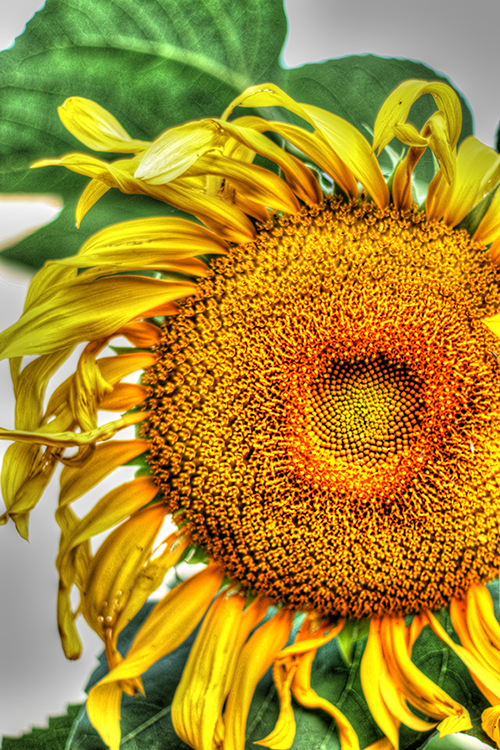3.3 This photo was shot with the Night Portrait mode. The camera slowed the shutter speed down enough to capture the lights on the house and in my daughter’s shoes. (12-24mm lens at 12mm, ISO 800, f/4.0, 1/6 second)
Chapter 3: Choosing the Right Settings for Your Camera
You’ve probably noticed all of the buttons on the back of your camera and are wondering what they do. This chapter covers the functions of many of these buttons, including how they adjust the exposure, focus, white balance, and drive modes. Your camera has a full line of modes to help you take great photos. Certain modes are better for particular situations, so it’s important to understand what they do and how they benefit your photography. Some types of photography require fast shutter speeds, while others look better with a shallow depth of field—all of which are handled effectively by your camera’s 14 exposure modes. Focus modes help keep your subject in or out of focus (depending on the desired result), while white balance can give you the best colors in a scene. Flash modes help you control light—the most important element in photography.
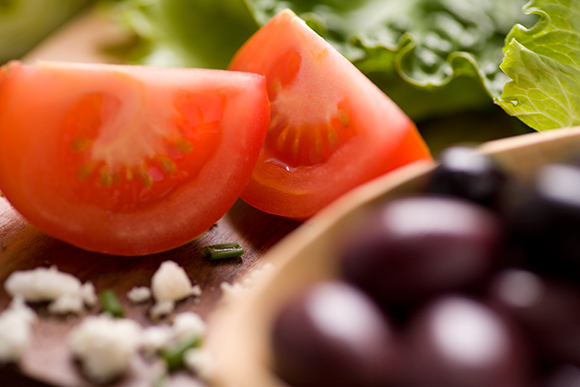
This image uses the foreground and a shallow depth of field to lead your eye to the tomatoes.
The Basic Zone Modes
Your camera has some excellent options to help you take the best image for different types of photography. Portraits, landscapes, and sports require preferred settings to capture the best image. The automatic modes are easy to recognize because they use icons representing the type of photography for which they are best used.

3.1 The basic zone modes make it easy to take a photo—all you have to do is press the shutter button.
The basic zone modes are easy to use—just press the shutter button for a proper exposure. The following are the basic zone modes on the Canon T4i/650D:
▶ Scene Intelligent Auto mode (![]() ). This is the ultimate program mode. It analyzes the scene and sets the shutter, aperture, ISO, white balance, and focus modes to take the best photograph. It uses all nine zones of focus to focus on the closest subject in the frame. If the camera detects a moving subject, it switches to the AI Servo mode (
). This is the ultimate program mode. It analyzes the scene and sets the shutter, aperture, ISO, white balance, and focus modes to take the best photograph. It uses all nine zones of focus to focus on the closest subject in the frame. If the camera detects a moving subject, it switches to the AI Servo mode (![]() ) to follow-focus. The camera uses the flash when necessary, such as in backlighting situations.
) to follow-focus. The camera uses the flash when necessary, such as in backlighting situations.
TIP When using the pop-up flash, you should stand at least 3.3 feet away from the subject to properly expose it. If you are too close, the bottom of the photo may be dark.
▶ Flash off mode (![]() ). If you don’t want your flash to turn on at any time, use the Flash off mode (
). If you don’t want your flash to turn on at any time, use the Flash off mode (![]() ). This mode is the same as the Scene Intelligent Auto mode (
). This mode is the same as the Scene Intelligent Auto mode (![]() ) without the flash. It is helpful when shooting in places where flash is distracting or not allowed, such as at a museum.
) without the flash. It is helpful when shooting in places where flash is distracting or not allowed, such as at a museum.
▶ Creative Auto mode (![]() ). This setting uses the Scene Intelligent Auto mode (
). This setting uses the Scene Intelligent Auto mode (![]() ) as a default setting, but gives you a host of creative options. Press the Quick Control/Print button (
) as a default setting, but gives you a host of creative options. Press the Quick Control/Print button (![]() ) to view a screen with the Creative Auto (
) to view a screen with the Creative Auto (![]() ) options. From there, make adjustments using the touch screen or traditional controls. This mode allows you to change the ambience options and control the depth of field with a convenient slider to adjust the amount of blur you want in the background. The Drive mode (
) options. From there, make adjustments using the touch screen or traditional controls. This mode allows you to change the ambience options and control the depth of field with a convenient slider to adjust the amount of blur you want in the background. The Drive mode (![]() ), Self-timer drive mode (
), Self-timer drive mode (![]() ), and flash controls are also available.
), and flash controls are also available.
NOTE Ambience effects are available in all basic modes, except Scene Intelligent Auto (![]() ), Flash off (
), Flash off (![]() ), and HDR backlight (
), and HDR backlight (![]() ).
).
▶ Portrait mode (![]() ). This mode (
). This mode (![]() ) sets your aperture to the lowest possible number to create a shallow depth of field. A shallow depth of field blurs the background to separate the subject from it, which keeps the focus on your subject. This mode is for more than portraits, though. Any time you need a shallow depth of field for food, product, or pet photography, use the Portrait mode (
) sets your aperture to the lowest possible number to create a shallow depth of field. A shallow depth of field blurs the background to separate the subject from it, which keeps the focus on your subject. This mode is for more than portraits, though. Any time you need a shallow depth of field for food, product, or pet photography, use the Portrait mode (![]() ). Use the Quick Control/Print button (
). Use the Quick Control/Print button (![]() ) to adjust ambience settings, color scene filters for white balance, and shooting modes.
) to adjust ambience settings, color scene filters for white balance, and shooting modes.
NOTE If you want to see what your depth of field looks like in advance, press the Depth-of-Field Preview button (![]() ) on the front of your camera.
) on the front of your camera.
▶ Landscape mode (![]() ). The goal of this mode is to give you the largest depth of field possible. In this mode, you have control over the ambience setting, color scene filters for white balance, and shooting modes.
). The goal of this mode is to give you the largest depth of field possible. In this mode, you have control over the ambience setting, color scene filters for white balance, and shooting modes.
CAUTION When shooting landscapes, be aware that the shutter speed greatly slows down as the sun sets. Make sure that you use a tripod if the shutter speed goes below 1/30 second.
▶ Close-up mode (![]() ). This mode is designed for close-up photography, like the image shown in Figure 3.2. It is similar to Portrait mode (
). This mode is designed for close-up photography, like the image shown in Figure 3.2. It is similar to Portrait mode (![]() ) because it is designed to help pop your subject from the background using a shallow depth of field while leaving enough depth to see small subjects. In this mode, you have control over the ambience setting, color scene filters for white balance, and shooting modes.
) because it is designed to help pop your subject from the background using a shallow depth of field while leaving enough depth to see small subjects. In this mode, you have control over the ambience setting, color scene filters for white balance, and shooting modes.
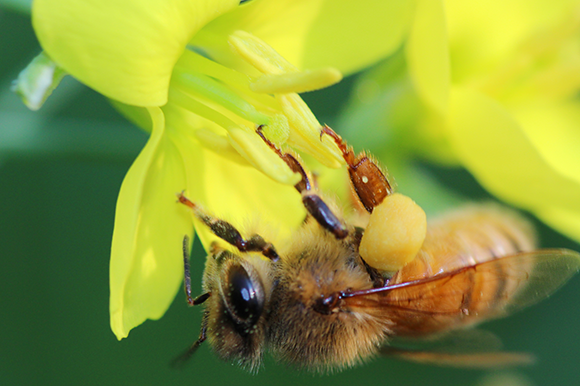
3.2 This image was shot in the Close-up mode. (100mm macro lens, ISO 400, f/5.6, 1/160 second)
▶ Sports mode (![]() ). The goal of sports photography is to keep the shutter at the highest level possible. Sports mode (
). The goal of sports photography is to keep the shutter at the highest level possible. Sports mode (![]() ) is a good option any time you are shooting moving objects. The default shooting mode is Continuous, which photographs at a rate of approximately 5 frames per second. You can also use Sports mode (
) is a good option any time you are shooting moving objects. The default shooting mode is Continuous, which photographs at a rate of approximately 5 frames per second. You can also use Sports mode (![]() ) to photograph active children. In this mode, you have control over the ambience setting, color scene filters for white balance, and shooting modes.
) to photograph active children. In this mode, you have control over the ambience setting, color scene filters for white balance, and shooting modes.
▶ Night Portrait mode (![]() ). Use this mode when it is dark outside and you want to capture background lights. This mode combines flash to freeze your subject and a slow shutter speed to expose for the light in the background. If you move the camera, though, it creates ghosting (motion blur that often occurs when using a slow shutter speed with flash). In this mode, you have control of the ambience settings and shooting modes.
). Use this mode when it is dark outside and you want to capture background lights. This mode combines flash to freeze your subject and a slow shutter speed to expose for the light in the background. If you move the camera, though, it creates ghosting (motion blur that often occurs when using a slow shutter speed with flash). In this mode, you have control of the ambience settings and shooting modes.

3.3 This photo was shot with the Night Portrait mode. The camera slowed the shutter speed down enough to capture the lights on the house and in my daughter’s shoes. (12-24mm lens at 12mm, ISO 800, f/4.0, 1/6 second)
▶ Handheld Night Scene mode (![]() ). Exposing for bright city lights and street detail is difficult. Usually this type of photography requires a tripod. The Handheld Night Scene mode (
). Exposing for bright city lights and street detail is difficult. Usually this type of photography requires a tripod. The Handheld Night Scene mode (![]() ), which was used to shoot Figure 3.4, allows you to hold the camera while it takes four consecutive shots at different exposures. The camera then combines the four images to create one. This mode is very useful when shooting street scenes at night, especially cities. These scenes typically have a lot of bright lights that blow out and dark areas that turn black—this mode handles those issues well. The default setting in this mode is Flash off (
), which was used to shoot Figure 3.4, allows you to hold the camera while it takes four consecutive shots at different exposures. The camera then combines the four images to create one. This mode is very useful when shooting street scenes at night, especially cities. These scenes typically have a lot of bright lights that blow out and dark areas that turn black—this mode handles those issues well. The default setting in this mode is Flash off (![]() ). If you want to take portraits in this mode, press the Quick Control/Print button (
). If you want to take portraits in this mode, press the Quick Control/Print button (![]() ) and turn on the flash. The first exposure triggers the flash, so make sure to tell your subject not to move during the additional three exposures. You also have control of color scene filters and shooting modes.
) and turn on the flash. The first exposure triggers the flash, so make sure to tell your subject not to move during the additional three exposures. You also have control of color scene filters and shooting modes.

3.4 Using the Handheld Night Scene mode, the camera took four quick photos to expose for the bright lights and dark sky. (Multiple exposures, 24mm lens, ISO 4000)
NOTE Although the flash goes off only once when it is turned on in the Handheld Night Scene mode (![]() ), ask your subject to remain still until the camera takes all four shots.
), ask your subject to remain still until the camera takes all four shots.
▶ HDR Backlight mode (![]() ). High Dynamic Range (HDR) exposes for both highlights and shadow detail by combining multiple photographs at different exposures. The HDR Backlight mode (
). High Dynamic Range (HDR) exposes for both highlights and shadow detail by combining multiple photographs at different exposures. The HDR Backlight mode (![]() ) takes three quick exposures and combines them into one image to compensate for any intense light behind your subject. For example, if you’re shooting a statue with the sun behind it and you don’t want to create a silhouette, use the HDR Backlight mode (
) takes three quick exposures and combines them into one image to compensate for any intense light behind your subject. For example, if you’re shooting a statue with the sun behind it and you don’t want to create a silhouette, use the HDR Backlight mode (![]() ) to improve both the highlight and shadow detail for a properly exposed photo.
) to improve both the highlight and shadow detail for a properly exposed photo.
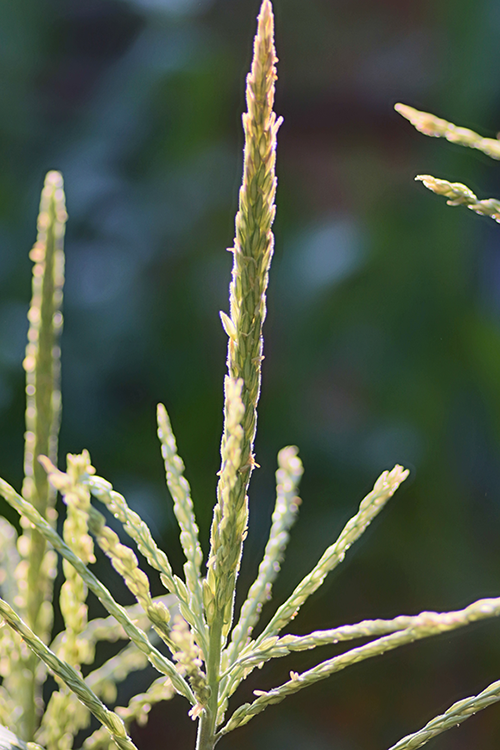
3.5 Three rapid shots were taken in the HDR Backlight mode and combined in the camera to create this image.
NOTE Although you can handhold your camera when using the HDR Backlight mode (![]() ), you must remain very still. Consider using a tripod whenever possible. If you move the camera, the three images might not align correctly.
), you must remain very still. Consider using a tripod whenever possible. If you move the camera, the three images might not align correctly.
The Creative Zone Modes
Your camera’s creative zone modes are designed to give you more flexibility while taking photographs. Sometimes, you need control of the shutter, while other times the aperture is more important. When you’re not sure what is most important, you have the Program AE mode (![]() ). It takes over and uses the technology in your camera to help you create a well-exposed image.
). It takes over and uses the technology in your camera to help you create a well-exposed image.
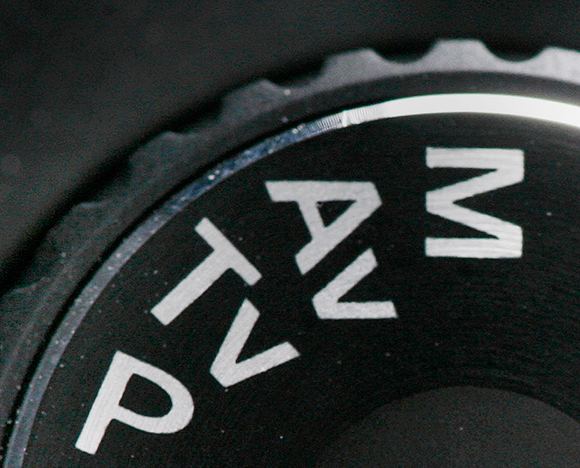
3.6 The creative zone modes include the Manual, Aperture-priority AE, Shutter-priority AE, and Program AE modes.
When you want a little more control over the exposure, use one of the following creative zone modes:
▶ Manual mode (![]() ). When you are comfortable with your camera, you may want to begin using Manual mode (
). When you are comfortable with your camera, you may want to begin using Manual mode (![]() ). It’s not for everyone, but there may be times when you disagree with the camera’s automatic settings, and want to take full control of the shutter speed and aperture. It is especially useful in difficult lighting, such as backlighting or when shooting night scenes. The camera displays how under- or overexposed the image will be based on its exposure meter readings. You can make adjustments based on the camera’s internal light meter information.
). It’s not for everyone, but there may be times when you disagree with the camera’s automatic settings, and want to take full control of the shutter speed and aperture. It is especially useful in difficult lighting, such as backlighting or when shooting night scenes. The camera displays how under- or overexposed the image will be based on its exposure meter readings. You can make adjustments based on the camera’s internal light meter information.
▶ Aperture-priority AE mode (![]() ). Some types of photography, such as landscape and portraiture, require that you control the depth of field. The Aperture–priority AE mode (
). Some types of photography, such as landscape and portraiture, require that you control the depth of field. The Aperture–priority AE mode (![]() ) gives you control over the aperture, while the camera controls the shutter. The aperture allows light into the camera, so as you open it, the camera increases the shutter speed to compensate. When you close down the aperture, the camera does the opposite.
) gives you control over the aperture, while the camera controls the shutter. The aperture allows light into the camera, so as you open it, the camera increases the shutter speed to compensate. When you close down the aperture, the camera does the opposite.
▶ Shutter-priority AE mode (![]() ). When photographing sports or wildlife, you need a fast shutter speed to freeze the action. When shooting landscapes, you often need a slower shutter speed to achieve a larger depth of field. The Shutter–priority AE mode (
). When photographing sports or wildlife, you need a fast shutter speed to freeze the action. When shooting landscapes, you often need a slower shutter speed to achieve a larger depth of field. The Shutter–priority AE mode (![]() ) gives you control of the shutter speed, while the camera controls the aperture. As you increase the shutter speed, the camera opens up the aperture to allow more light into the camera; when you lower the shutter speed, the camera closes the aperture.
) gives you control of the shutter speed, while the camera controls the aperture. As you increase the shutter speed, the camera opens up the aperture to allow more light into the camera; when you lower the shutter speed, the camera closes the aperture.
▶ Program AE mode (![]() ). When you don’t know what to do or just don’t want to think about the finer points of composition and light, use the Program AE mode (
). When you don’t know what to do or just don’t want to think about the finer points of composition and light, use the Program AE mode (![]() ). It gives you the confidence you need to take good photos with a little more control than the automatic basic zone modes. Program AE mode (
). It gives you the confidence you need to take good photos with a little more control than the automatic basic zone modes. Program AE mode (![]() ) sets the shutter speed and aperture for the proper exposure. Unlike the Scene Intelligent Auto shooting mode (
) sets the shutter speed and aperture for the proper exposure. Unlike the Scene Intelligent Auto shooting mode (![]() ), it doesn’t automatically set Picture Styles, white balance, focusing modes, or the ISO (
), it doesn’t automatically set Picture Styles, white balance, focusing modes, or the ISO (![]() ).
).
Focus Modes
Autofocus is a standard feature on most cameras. Camera manufacturers are improving autofocus systems all of the time by adding new capabilities. However, how to use these capabilities is often a mystery. The type of photography you plan on doing usually determines the best autofocus solution. Autofocus is not perfect; sometimes you have to use Manual focus (![]() ). The Autofocus/Manual focus switch, as shown in Figure 3.7, is on the left side of your lens—don’t be afraid to use it. To change your autofocus mode, press the Autofocus button (
). The Autofocus/Manual focus switch, as shown in Figure 3.7, is on the left side of your lens—don’t be afraid to use it. To change your autofocus mode, press the Autofocus button (![]() ), which is located to the right of the Set button (
), which is located to the right of the Set button (![]() ). Next, select one of the three focus modes. You will know if your subject is in focus if the round focus confirmation light appears in the bottom-right corner of the viewfinder.
). Next, select one of the three focus modes. You will know if your subject is in focus if the round focus confirmation light appears in the bottom-right corner of the viewfinder.
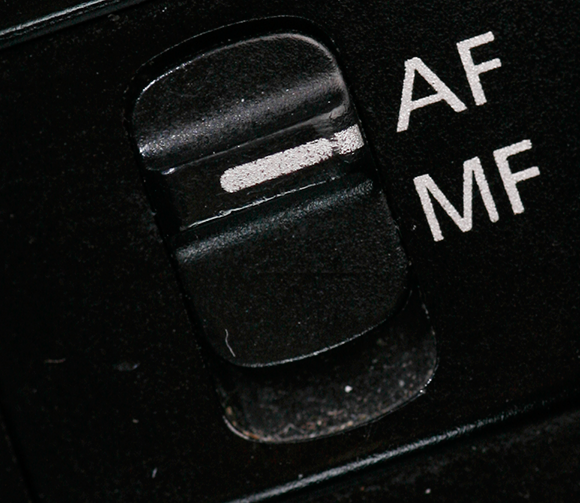
3.7 The Autofocus/Manual focus switch on a lens.
The following list includes the focusing options available on the Canon T4i/650D:
▶ Autofocus mode (![]() ). If you are using a basic zone mode, the optimal focus for that mode is automatically set. For example, in Sports mode (
). If you are using a basic zone mode, the optimal focus for that mode is automatically set. For example, in Sports mode (![]() ), the camera sets the focus to the AI Servo focusing mode (
), the camera sets the focus to the AI Servo focusing mode (![]() ) to follow-focus on moving subjects. In the creative zone modes, you can change the focus mode or focus points at any time. If you see the round focus confirmation light blinking in the viewfinder, this means that the camera is having trouble focusing, and you may need to try one of the other focus modes.
) to follow-focus on moving subjects. In the creative zone modes, you can change the focus mode or focus points at any time. If you see the round focus confirmation light blinking in the viewfinder, this means that the camera is having trouble focusing, and you may need to try one of the other focus modes.

3.8 Patterns in low light can make it tough for your camera to focus.
▶ Manual focusing mode (![]() ). You will not always agree with your camera’s choice of focus. It is programmed, when using the default automatic AF point selection, to focus on the largest, closest object to the lens. This default does not always match what you want to photograph. You can try using individual focus points to force your desired focus point but, in many cases, Manual focusing mode (
). You will not always agree with your camera’s choice of focus. It is programmed, when using the default automatic AF point selection, to focus on the largest, closest object to the lens. This default does not always match what you want to photograph. You can try using individual focus points to force your desired focus point but, in many cases, Manual focusing mode (![]() ) is your best bet. The following is a list of situations in which you might want to switch to the Manual focusing mode (
) is your best bet. The following is a list of situations in which you might want to switch to the Manual focusing mode (![]() ) or select one of the nine focal points:
) or select one of the nine focal points:
• When shooting low-contrast subjects, such as the sky or a gray wall
• When a subject is in low light
• When shooting repetitive patterns, such as rows of windows on a building
• When shooting horizontal stripes
• When shooting water or other reflective subjects
• When an object is too close to the camera (you may also need to back up or change lenses)
NOTE If focus cannot be achieved (because you are too close to the subject or the environment is too dark, for example), the round focus confirmation light blinks.
• When shooting a subject with extreme backlighting, such as a small object with the sun behind it
• When shooting very small subjects (use a macro lens)
• When a subject is too far way for the camera to detect
▶ One-shot autofocus mode (![]() ). This is a good mode to use when you are photographing a still subject. Point your camera at the subject, and then press the shutter button halfway. The camera focus locks on the subject. When you see the round focus confirmation light in your viewfinder, you are free to recompose. If you need to refocus, lift your finger off of the shutter button and focus again.
). This is a good mode to use when you are photographing a still subject. Point your camera at the subject, and then press the shutter button halfway. The camera focus locks on the subject. When you see the round focus confirmation light in your viewfinder, you are free to recompose. If you need to refocus, lift your finger off of the shutter button and focus again.
NOTE In One-shot autofocus mode (![]() ), the camera takes its exposure settings at the same time that you lock focus.
), the camera takes its exposure settings at the same time that you lock focus.
▶ Al Servo focusing mode (![]() ). Photographing moving objects is not easy. The AI Servo focusing mode (
). Photographing moving objects is not easy. The AI Servo focusing mode (![]() ) continuously refocuses on your subject until you fully press the shutter button to take a photograph. Pressing the shutter button halfway is a good idea so you can snap your picture quickly, but it doesn’t stop the camera from refocusing as you move your lens or as the subject moves.
) continuously refocuses on your subject until you fully press the shutter button to take a photograph. Pressing the shutter button halfway is a good idea so you can snap your picture quickly, but it doesn’t stop the camera from refocusing as you move your lens or as the subject moves.
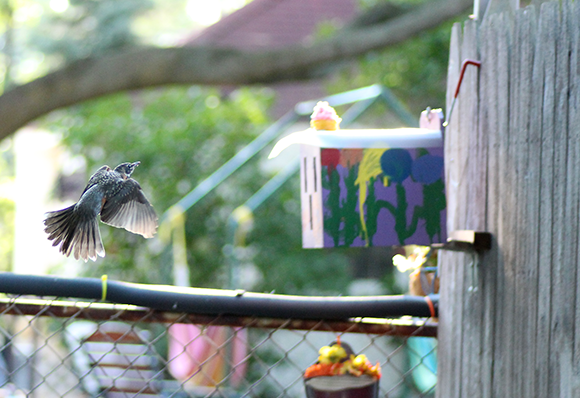
3.9 I followed this robin in the Al Servo mode to keep it in focus as it flew to the fence. (100mm lens, ISO 1600, f/2.8, 1/000 second)
NOTE The round focus confirmation light does not blink in the Al Servo focusing mode (![]() ), even if the subject is in focus.
), even if the subject is in focus.
▶ Al focus (![]() ). If your subject starts to move while you are photographing in the One-shot autofocus mode (
). If your subject starts to move while you are photographing in the One-shot autofocus mode (![]() ), it may be out of focus by the time you press the shutter button. The Al focus mode (
), it may be out of focus by the time you press the shutter button. The Al focus mode (![]() ) defaults to the One-shot autofocus mode (
) defaults to the One-shot autofocus mode (![]() ), but switches to AI Servo mode (
), but switches to AI Servo mode (![]() ) if the subject moves. For example, if you are photographing an animal in the wild, the camera defaults to One-shot autofocus mode (
) if the subject moves. For example, if you are photographing an animal in the wild, the camera defaults to One-shot autofocus mode (![]() ) if the subject remains still. If something spooks the creature and it moves, your camera switches to AI Servo mode (
) if the subject remains still. If something spooks the creature and it moves, your camera switches to AI Servo mode (![]() ) as you follow the animal. When using the Al focus mode (
) as you follow the animal. When using the Al focus mode (![]() ), the default One-shot autofocus mode (
), the default One-shot autofocus mode (![]() ) lights up the round focus confirmation light. When it switches to the Al Servo mode (
) lights up the round focus confirmation light. When it switches to the Al Servo mode (![]() ), the light shuts off.
), the light shuts off.
▶ Focus points. Your Canon Rebel T4i/650D uses nine focus points (in Live View shooting mode (![]() ) it has up to 31 focus points). It automatically focuses on the subject closest to the lens using one of these points. If the camera doesn’t focus on the main subject, switch to Manual focusing mode (
) it has up to 31 focus points). It automatically focuses on the subject closest to the lens using one of these points. If the camera doesn’t focus on the main subject, switch to Manual focusing mode (![]() ) if you are using one of the basic zone modes. In the Program AE (
) if you are using one of the basic zone modes. In the Program AE (![]() ), Manual (
), Manual (![]() ), Aperture-priority AE (
), Aperture-priority AE (![]() ), and Shutter-priority AE (
), and Shutter-priority AE (![]() ) modes, you can press the AF point selection button (
) modes, you can press the AF point selection button (![]() ) to manually set the focus point that you want. It is common to set the middle focus point as the default so that you can point the camera at the subject, lock the focus by pressing the shutter button halfway, and then recompose the scene. When all points of focus are lighted, the camera is in autofocus mode and chooses the point of focus for you.
) to manually set the focus point that you want. It is common to set the middle focus point as the default so that you can point the camera at the subject, lock the focus by pressing the shutter button halfway, and then recompose the scene. When all points of focus are lighted, the camera is in autofocus mode and chooses the point of focus for you.
▶ AF–assist beam (![]() ). When light is low, this beam fires to help your camera focus on the subject. It works automatically in basic zone modes and only if the flash is popped up in creative modes. The beam is actually emitted from your flash quickly triggering in a rapid cycle. The AF-assist beam does not function in the Flash off (
). When light is low, this beam fires to help your camera focus on the subject. It works automatically in basic zone modes and only if the flash is popped up in creative modes. The beam is actually emitted from your flash quickly triggering in a rapid cycle. The AF-assist beam does not function in the Flash off (![]() ), Sports (
), Sports (![]() ), or Landscape (
), or Landscape (![]() ) modes.
) modes.
CAUTION Make sure that you warn your subjects not to move if the AF-assist beam fires. It is common for subjects to leave thinking that you already took the photo.
▶ Tracking modes. Your camera has three tracking modes in the Live View shooting mode (![]() ). The first option, Face Tracking (
). The first option, Face Tracking (![]() ), looks for faces. If no face it detected, it switches to Flexizone-Multi (
), looks for faces. If no face it detected, it switches to Flexizone-Multi (![]() ) and tracks whatever you point to on the LCD touch screen. When the camera detects a face, it switches back to Face Tracking mode (
) and tracks whatever you point to on the LCD touch screen. When the camera detects a face, it switches back to Face Tracking mode (![]() ) and follows it. In the Flexizone-Multi mode (
) and follows it. In the Flexizone-Multi mode (![]() ), you have 31 focusing touch zones. If you press the Set button (
), you have 31 focusing touch zones. If you press the Set button (![]() ), the center zone lights up and tracks any object it detects. Use the Cross keys for fine adjustments or the touch screen to select a specific object in your frame. The Flexizone-Single mode (
), the center zone lights up and tracks any object it detects. Use the Cross keys for fine adjustments or the touch screen to select a specific object in your frame. The Flexizone-Single mode (![]() ) uses only one AF point, and does not adjust with the movement of the camera or subject. You may adjust the focus point using the Cross keys or LCD touch screen.
) uses only one AF point, and does not adjust with the movement of the camera or subject. You may adjust the focus point using the Cross keys or LCD touch screen.
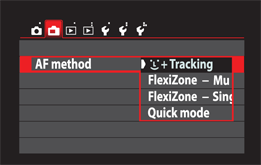
3.10 The AF tracking options in the Live View Shooting menu.
CAUTION If you press the shutter button halfway, even in a Tracking mode, the camera refocuses.
▶ Live View shooting mode (![]() ). When your camera is in this mode, you have four focusing options. To get to them, press the Menu button (
). When your camera is in this mode, you have four focusing options. To get to them, press the Menu button (![]() ) when the camera is in the Live View shooting mode (
) when the camera is in the Live View shooting mode (![]() ), and then select the AF method you want to use. You may adjust the focus method by pressing the Quick Control/Print button (
), and then select the AF method you want to use. You may adjust the focus method by pressing the Quick Control/Print button (![]() ) for options. The Quick focus mode (
) for options. The Quick focus mode (![]() ) is a good default because it focuses quickly. If you are in a basic zone mode, such as Portrait mode (
) is a good default because it focuses quickly. If you are in a basic zone mode, such as Portrait mode (![]() ), the camera selects the focus zones. If you are using a creative zone mode, such as Aperture-priority AE (
), the camera selects the focus zones. If you are using a creative zone mode, such as Aperture-priority AE (![]() ), you may select the focus zone via the LCD touch screen or Cross keys. Your other options are the slower (but useful) tracking methods of focus.
), you may select the focus zone via the LCD touch screen or Cross keys. Your other options are the slower (but useful) tracking methods of focus.
CROSS REF For more about the Live View Shooting mode (![]() ), see Chapter 8.
), see Chapter 8.
Picture Styles
Different types of photography look better with certain adjustments. Picture Styles (![]() ) help when you want to add a little more to your images. Your camera has seven options, plus three customized, user-defined Picture Styles. Each Picture Style adjusts sharpness, contrast, saturation, and color tone.
) help when you want to add a little more to your images. Your camera has seven options, plus three customized, user-defined Picture Styles. Each Picture Style adjusts sharpness, contrast, saturation, and color tone.
NOTE Picture Style options only work in the Progam AE (![]() ), Manual (
), Manual (![]() ), Aperture-priority AE (
), Aperture-priority AE (![]() ), and Shutter-priority AE (
), and Shutter-priority AE (![]() ) modes.
) modes.
The following Picture Styles are available on the Canon T4i/650D:
▶ Auto (![]() ). This mode starts out as a neutral setting, but adjusts based on the detected scene. It is a good default if you don’t want any specific adjustments applied to photographs.
). This mode starts out as a neutral setting, but adjusts based on the detected scene. It is a good default if you don’t want any specific adjustments applied to photographs.
▶ Standard (![]() ). This is another good default Picture Style setting. It adds sharpness and produces vivid colors in your scene. Unlike the Auto Picture Style (
). This is another good default Picture Style setting. It adds sharpness and produces vivid colors in your scene. Unlike the Auto Picture Style (![]() ), it does adjust to different types of scenes.
), it does adjust to different types of scenes.
▶ Portrait (![]() ). This Picture Style softens the image. The default leaves all of the other tones in neutral settings, but you may want to adjust the skin tone to suit your style or subject. To do so, in the Picture Style menu (
). This Picture Style softens the image. The default leaves all of the other tones in neutral settings, but you may want to adjust the skin tone to suit your style or subject. To do so, in the Picture Style menu (![]() ), select Info and four options (Sharpness, Contrast, Saturation, and Color tone) appear. If you select Color tone, your subject will look more red the closer you get to the minus sign. The closer you get to the plus sign, the more yellow it will appear.
), select Info and four options (Sharpness, Contrast, Saturation, and Color tone) appear. If you select Color tone, your subject will look more red the closer you get to the minus sign. The closer you get to the plus sign, the more yellow it will appear.
▶ Landscape (![]() ). Use this Picture Style to create impressive landscapes. It is sharp and produces vivid blues and greens.
). Use this Picture Style to create impressive landscapes. It is sharp and produces vivid blues and greens.
▶ Neutral (![]() ). If you prefer to enhance your photos using software outside the camera, then the Neutral Picture Style (
). If you prefer to enhance your photos using software outside the camera, then the Neutral Picture Style (![]() ) is a good choice. It is designed to produce natural-looking colors.
) is a good choice. It is designed to produce natural-looking colors.
▶ Faithful (![]() ). This is another Picture Style that is ideal for people who like to process their images on the computer. Of all of the Picture Styles, it offers the best color representation based on a white light exposure of 5200K.
). This is another Picture Style that is ideal for people who like to process their images on the computer. Of all of the Picture Styles, it offers the best color representation based on a white light exposure of 5200K.
NOTE Kelvin is the temperature measurement of light. Temperatures between 5500K and 6000K are considered neutral (or white) light. Lower Kelvin temperatures produce light that appears warmer, and higher temperatures produce light that looks cooler.
▶ Monochrome (![]() ). Choose the Monochrome Picture Style (
). Choose the Monochrome Picture Style (![]() ) if you want to take black-and-white photos, as shown in Figure 3.11. Because the Monochrome Picture Style (
) if you want to take black-and-white photos, as shown in Figure 3.11. Because the Monochrome Picture Style (![]() ) doesn’t need saturation or color tone, those options are replaced in the menu with filter and toning effects. The filter effect works like a color filter over black-and-white film, with the following options: None, Yellow, Orange, Red, and Green. Each of these filters absorbs the color it represents. Toning effects change the monochromatic color of the image. The options are None, Sepia, Blue, Purple, and Green.
) doesn’t need saturation or color tone, those options are replaced in the menu with filter and toning effects. The filter effect works like a color filter over black-and-white film, with the following options: None, Yellow, Orange, Red, and Green. Each of these filters absorbs the color it represents. Toning effects change the monochromatic color of the image. The options are None, Sepia, Blue, Purple, and Green.

3.11 The Monochrome Picture Style. (ISO 400, f/5.6, 1/20 second)

3.12 The Monochrome Picture Style with a yellow filter. (ISO 400, f/5.6, 1/20 second)
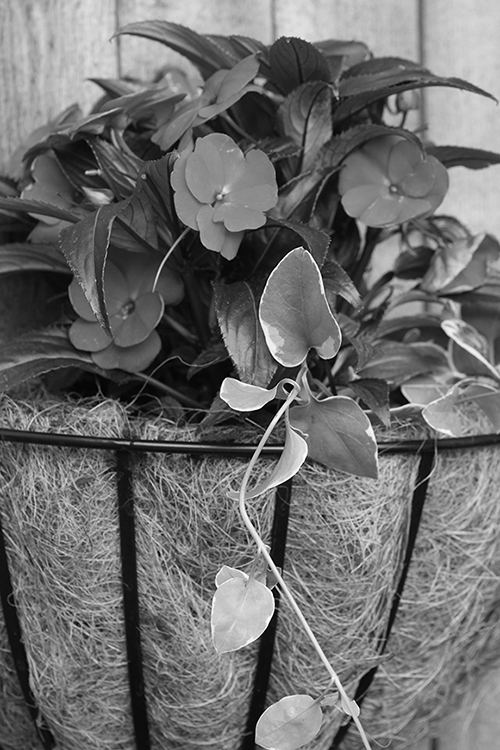
3.13 The Monochrome Picture Style with an orange filter. (ISO 400, f/5.6, 1/20 second)

3.14 The Monochrome Picture Style with a red filter. (ISO 400, f/5.6, 1/20 second)
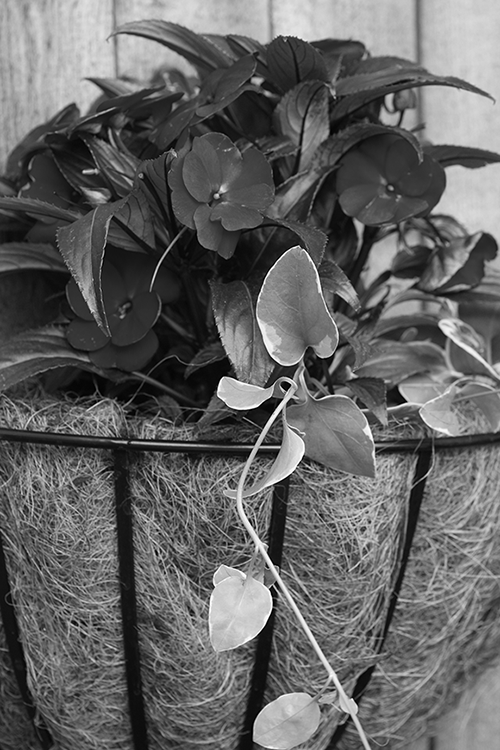
3.15 The Monochrome Picture Style with a green filter. (ISO 400, f/5.6, 1/20 second)
CAUTION If you think that you might want to convert your photograph to a color image later, make sure that you use the RAW setting (![]() ). Other image formats, such as JPEG, cannot be converted back to color.
). Other image formats, such as JPEG, cannot be converted back to color.
▶ User-defined Picture Styles 1 (![]() ), 2 (
), 2 (![]() ), and 3 (
), and 3 (![]() ). Here, you can create your own Picture Styles. Unused Picture Styles default to the Auto Picture Style. You may use any of the camera’s preset Picture Styles as a starting point to create your own custom styles. The following settings can be adjusted to create a custom style:
). Here, you can create your own Picture Styles. Unused Picture Styles default to the Auto Picture Style. You may use any of the camera’s preset Picture Styles as a starting point to create your own custom styles. The following settings can be adjusted to create a custom style:
• Sharpness. This adjusts the clarity of the image. The closer to 0 the sharpness is, the softer the image. The closer to 7 this setting is, the sharper the image.
• Contrast. Use this setting to increase or decrease the contrast or vividness of the colors in your image. The closer to 0 the contrast is, the duller the image. The closer to the plus sign (+) the setting is, the more contrast and vividness the image has.
• Saturation. This enhances the colors in your image. The closer to 0 it is, the more muted the colors. The closer to the plus sign (+) it is, the bolder the colors.
• Color tone. Use this setting to adjust skin tones. The closer to 0 it is, the more red your subject’s skin tones look. The closer to the plus sign (+) it is, the more yellow they appear.
Drive Modes
Your camera has five Drive modes (![]() ) and each has its benefits, depending on the type of photography you are doing. However, a lot is governed by personal preference. To quickly adjust this, press the Drive mode button (
) and each has its benefits, depending on the type of photography you are doing. However, a lot is governed by personal preference. To quickly adjust this, press the Drive mode button (![]() ) located to the right of the Set button (
) located to the right of the Set button (![]() ) on the back of your camera.
) on the back of your camera.
The following drive modes are available on the Canon T4i/650D:
▶ Single-shooting mode (![]() ). In this mode, the camera takes only one photograph with each press of the shutter button. It is most useful for portraits and landscapes.
). In this mode, the camera takes only one photograph with each press of the shutter button. It is most useful for portraits and landscapes.
▶ Continuous drive mode (![]() ). This mode is helpful when shooting action, such as sports, children, or wildlife. Use it when you need to take multiple photographs in quick succession—it shoots approximately 5 frames per second (fps). It is also helpful to have your camera on Al Servo (
). This mode is helpful when shooting action, such as sports, children, or wildlife. Use it when you need to take multiple photographs in quick succession—it shoots approximately 5 frames per second (fps). It is also helpful to have your camera on Al Servo (![]() ) or Al focus (
) or Al focus (![]() ) mode if your subject is moving.
) mode if your subject is moving.
NOTE If you use flash, the frames per second (fps) rate is slower because the flash must recycle.
▶ Self-timer drive modes (![]() ). When you press the Drive mode button (
). When you press the Drive mode button (![]() ), you see the following three self-timer options: 10 seconds (
), you see the following three self-timer options: 10 seconds (![]() ), 2 seconds (
), 2 seconds (![]() ), and a multi-shot continuous timer (
), and a multi-shot continuous timer (![]() ). The continuous timer starts as a 10-second timer, but takes up to 10 continuous photos.
). The continuous timer starts as a 10-second timer, but takes up to 10 continuous photos.
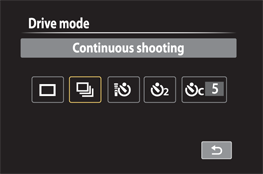
3.16 You have five Drive modes to choose from, including three Self-timer options.
White Balance Settings
Above the Set button (![]() ) on your camera, you’ll find the White Balance selection button (
) on your camera, you’ll find the White Balance selection button (![]() ). These settings are used to correct the light in your scene so that it is as close to neutral (or white light) as possible. In other words, the goal is to make a white piece of paper look white under any lighting conditions. White light has a temperature of between 5500K and 6000K (Kelvin). Kelvin is the unit of measurement used for the temperature of light. The higher the Kelvin temperature is, the cooler the appearance. The lower the Kelvin temperature is, the warmer the appearance. For example, an incandescent light bulb is around 3000K, which looks yellow, and a white fluorescent lamp is around 5000K, which is closer to white light. Each setting tells you what the Kelvin temperature is for each adjustment.
). These settings are used to correct the light in your scene so that it is as close to neutral (or white light) as possible. In other words, the goal is to make a white piece of paper look white under any lighting conditions. White light has a temperature of between 5500K and 6000K (Kelvin). Kelvin is the unit of measurement used for the temperature of light. The higher the Kelvin temperature is, the cooler the appearance. The lower the Kelvin temperature is, the warmer the appearance. For example, an incandescent light bulb is around 3000K, which looks yellow, and a white fluorescent lamp is around 5000K, which is closer to white light. Each setting tells you what the Kelvin temperature is for each adjustment.
You can choose from the following white balance settings:
▶ Auto (![]() ). This is a good default white balance mode for almost any scene because the camera adjusts the light automatically. If you are shooting in the RAW format, you can make additional adjustments to the light temperature in editing software, including the software that came with your camera, Photoshop Camera Raw, and Lightroom.
). This is a good default white balance mode for almost any scene because the camera adjusts the light automatically. If you are shooting in the RAW format, you can make additional adjustments to the light temperature in editing software, including the software that came with your camera, Photoshop Camera Raw, and Lightroom.
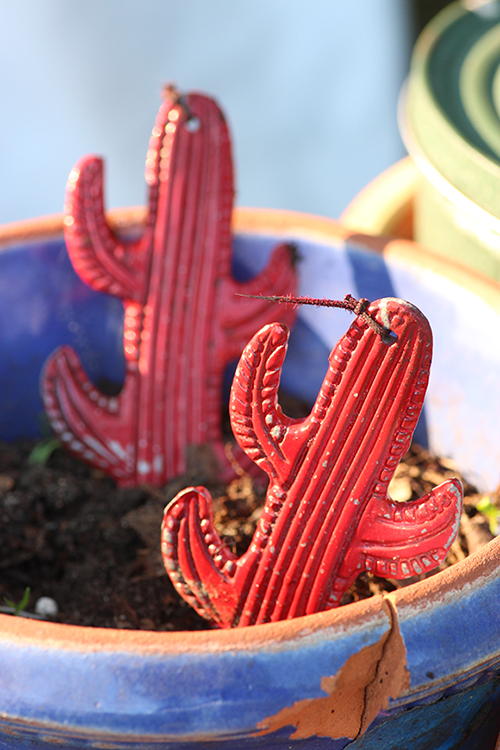
3.17 The result of the Auto white balance setting. (100mm lens, ISO 400, f/5.6, 1/80 second)
▶ Daylight (![]() ). You can use this setting on bright days when the sun is high in the sky. It is a more neutral setting than others. Some photographers prefer it to the flash setting when using an on-camera or external flash.
). You can use this setting on bright days when the sun is high in the sky. It is a more neutral setting than others. Some photographers prefer it to the flash setting when using an on-camera or external flash.

3.18 An example of the Daylight white balance setting. (100mm lens, ISO 400, f/5.6, 1/80 second)
▶ Shade (![]() ). This white balance setting has a higher (bluer) Kelvin temperature, so the camera adjusts the color to make the image warmer. Use this adjustment when you find yourself in dark shade or shadows.
). This white balance setting has a higher (bluer) Kelvin temperature, so the camera adjusts the color to make the image warmer. Use this adjustment when you find yourself in dark shade or shadows.
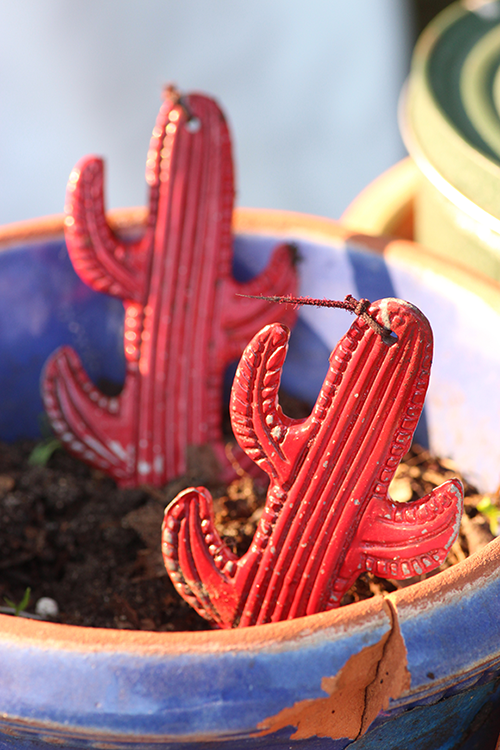
3.19 The Shade white balance setting was used on this image. (100mm lens, ISO 400, f/5.6, 1/80 second)
▶ Cloudy (![]() ). Like the Shade white balance setting (
). Like the Shade white balance setting (![]() ), the Cloudy setting (
), the Cloudy setting (![]() ) has a higher Kelvin temperature. Your camera is set to adjust a cool scene to make it look warmer. This is useful on cloudy days and in domed buildings where light penetrates the roof, such as a sports arena.
) has a higher Kelvin temperature. Your camera is set to adjust a cool scene to make it look warmer. This is useful on cloudy days and in domed buildings where light penetrates the roof, such as a sports arena.

3.20 An example of the Cloudy white balance setting. (100mm lens, ISO 400, f/5.6, 1/80 second)
▶ Tungsten (![]() ). Tungsten (the traditional round light bulb) is an artificial light that emits a yellow cast. This white balance setting adjusts light that is around 3200K. Incandescent lights turn more yellow over time, so results vary.
). Tungsten (the traditional round light bulb) is an artificial light that emits a yellow cast. This white balance setting adjusts light that is around 3200K. Incandescent lights turn more yellow over time, so results vary.
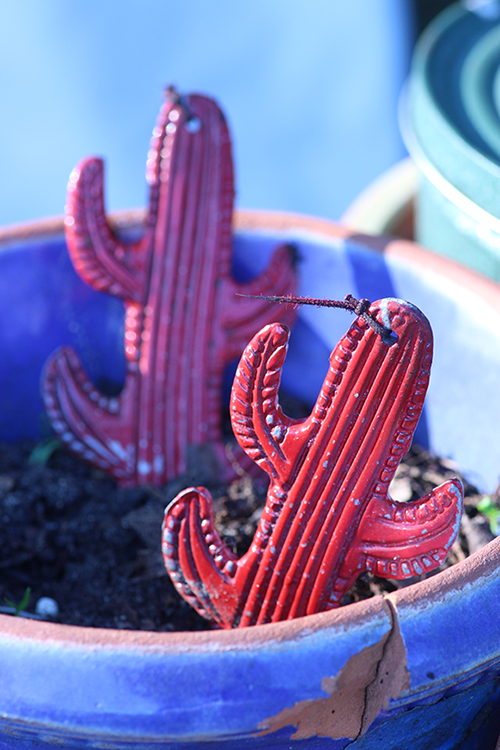
3.21 An example of Tungsten white balance setting. (100mm lens, ISO 400, f/5.6, 1/80 second)
▶ Fluorescent (![]() ). This is a good starting point to adjust fluorescent lights that are around 4000K (results depend on the type of fluorescent light used in your scene). Like incandescent bulbs, these change color over time, and there are many types on the market. If the Fluorescent white balance setting (
). This is a good starting point to adjust fluorescent lights that are around 4000K (results depend on the type of fluorescent light used in your scene). Like incandescent bulbs, these change color over time, and there are many types on the market. If the Fluorescent white balance setting (![]() ) doesn’t work to your satisfaction, consider using a Custom white balance setting (
) doesn’t work to your satisfaction, consider using a Custom white balance setting (![]() ).
).
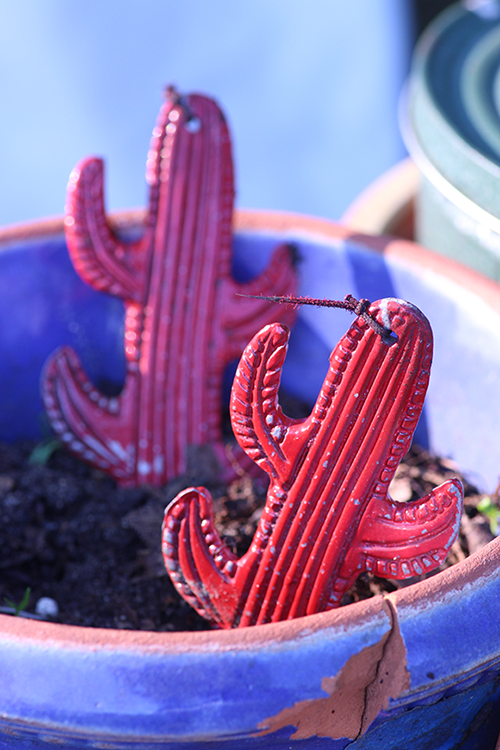
3.22 An example of the Fluorescent white balance. (100mm lens, ISO 400, f/5.6, 1/80 second)
▶ Flash (![]() ). This setting is designed for use with on-camera or external flashes. It is set to adjust light at 6000K to warm the cooler flash. If the image is too warm, you may want to consider using the Daylight white balance setting (
). This setting is designed for use with on-camera or external flashes. It is set to adjust light at 6000K to warm the cooler flash. If the image is too warm, you may want to consider using the Daylight white balance setting (![]() ).
).
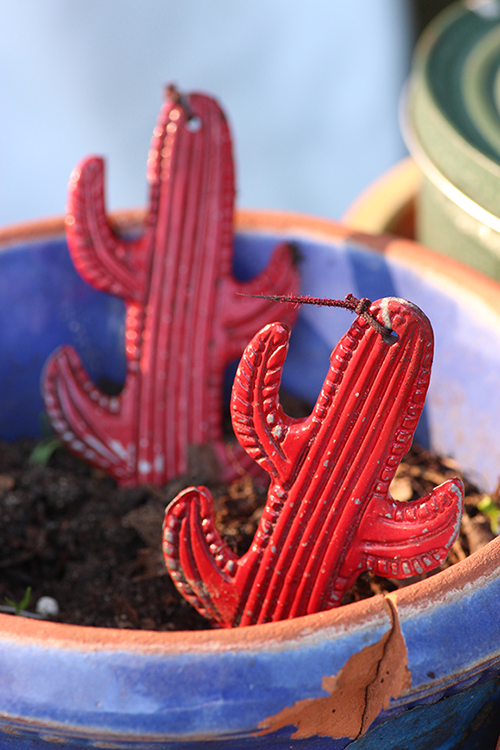
3.23 This photo is an example of the Flash white balance. (100mm lens, ISO 400, f/5.6, 1/80 second)
▶ Custom (![]() ). This setting allows you to set your white balance to any temperature for a more precise light-color balance. You should adjust your custom setting under the lighting conditions in which you plan to work.
). This setting allows you to set your white balance to any temperature for a more precise light-color balance. You should adjust your custom setting under the lighting conditions in which you plan to work.
▶ White Balance Auto Bracketing (![]() ). If you are not sure about the white balance results the camera will deliver, you can use what is called White Balance Auto Bracketing (
). If you are not sure about the white balance results the camera will deliver, you can use what is called White Balance Auto Bracketing (![]() ). To do so, press the Menu button (
). To do so, press the Menu button (![]() ) and, in the Shooting menu 2 (
) and, in the Shooting menu 2 (![]() ), you see WB shift/bkt. Once you make this selection, the camera displays the bracketing options, as shown in Figure 3.24.
), you see WB shift/bkt. Once you make this selection, the camera displays the bracketing options, as shown in Figure 3.24.
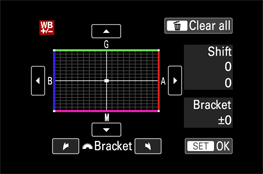
3.24 The White Balance Auto Bracketing menu. You can choose blue (B) to auburn (A), or green (G) to magenta (M) bracketing depending on your needs.
Flash Modes
This section focuses on the flash modes you can use with the pop-up flash. However, I highly recommend that you purchase a more powerful flash with additional features for regular use. The pop-up flash is for casual use when a larger one is unavailable.
The following flash modes are available on your camera:
▶ Auto. Most of the basic zone modes use the pop-up flash in low light. It is not used in the Landscape (![]() ) or HDR backlight (
) or HDR backlight (![]() ) modes.
) modes.
▶ Red-eye reduction. The Red-eye reduction feature (see Figure 3.25) is designed to prevent or minimize red eye in your subjects when you photograph them in a dark or dimly lit environment. The same as the camera’s aperture, pupils dilate in dark environments to let in more light. When this happens, more light reflects back to your camera. If your flash is close to your lens, your subjects will look like they have red eyes. When you press the shutter button half way, the Red-eye reduction lamp emits a light to shut the subject’s pupils down and reduce red-eye when using a flash mode. The light turns off when the shutter button is pressed completely. The Red-eye reduction setting does not work in the Flash off (![]() ), Landscape (
), Landscape (![]() ), Sports (
), Sports (![]() ), or HDR backlight (
), or HDR backlight (![]() ) modes.
) modes.
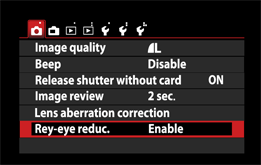
3.25 The Red-eye reduction feature is found in Shooting menu 1 when you are using a basic zone mode.
▶ Slow sync. When using flash, your camera sets the shutter speed between 1/60 second and 1/200 second. If you are in a dark environment, in most cases the background will appear black. If you want to see more of the environment or lights in the background, slow down the shutter speed while using flash. To do so, you can use the Shutter-priority AE (![]() ) or Manual (
) or Manual (![]() ) modes, which slow the shutter speed below 1/30 second. The best shutter speed depends on your ISO setting and how much light is in the background. The other option is to use the Night Portrait mode (
) modes, which slow the shutter speed below 1/30 second. The best shutter speed depends on your ISO setting and how much light is in the background. The other option is to use the Night Portrait mode (![]() ).
).
▶ Curtain sync. Ghosting leaves movement trails (or lights) behind your subject, as shown in Figures 3.26 and 3.27. This occurs when you combine flash with a low shutter speed. The flash freezes your subject and the camera records movement with the slow shutter. The default setting on all cameras is that the camera’s flash fires first, and then the slow shutter comes after leaving a front-moving trail. This is called using the front curtain. Your camera offers the option of either Front-curtain (first curtain) or Rear-curtain (second curtain) sync. In the Shooting menu 1 (![]() ), select Flash control. In that menu, select Built-in flash settings, and then select Shutter sync. Rear-curtain sync means that the slow shutter fires first, and then the flash. To get to this option, press the Menu button (
), select Flash control. In that menu, select Built-in flash settings, and then select Shutter sync. Rear-curtain sync means that the slow shutter fires first, and then the flash. To get to this option, press the Menu button (![]() ) and look in the first menu. Select flash control at the bottom, and then select Built-in flash settings. Go to Shutter Sync and choose your setting (First or Second curtain).
) and look in the first menu. Select flash control at the bottom, and then select Built-in flash settings. Go to Shutter Sync and choose your setting (First or Second curtain).
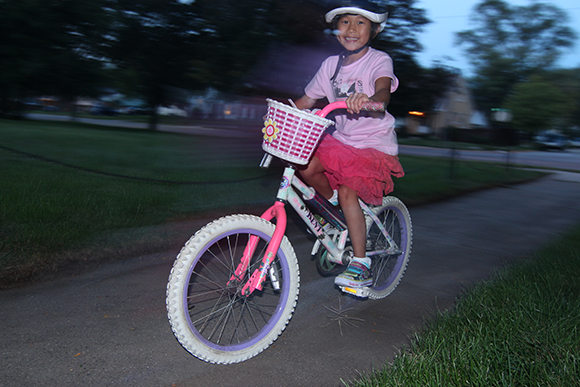
3.26 I used Front-curtain sync for this image. The flash fired immediately and the slow shutter speed left a trail moving in front of the subject. (12-24mm lens at 18mm, ISO 400, f/6.3, 1/4 second)
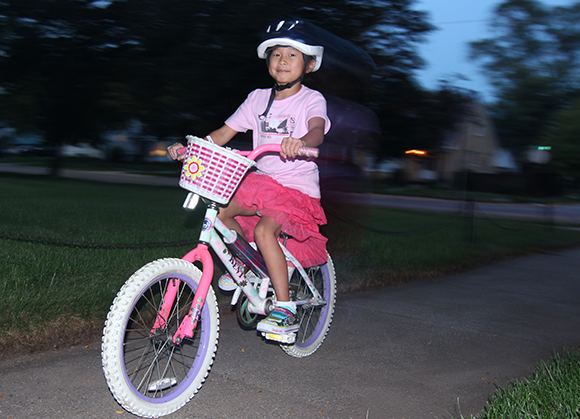
3.27 I used Rear-curtain sync for this image. The flash fired at the end of the slow shutter speed exposure, leaving a trail behind the subject. (12-24mm lens at 21mm, ISO 400, f/7.1, 1/3 second)
▶ Fill flash. The sun can cast harsh shadows on your subject’s face. You can use fill flash from the camera’s pop-up or external flash to help minimize the shadows. If you place your subject in the shade with a bright background or in a direct backlight situation, use fill flash to prevent your subject from becoming a silhouette. If you are using a basic zone mode, your camera activates the built-in flash if it senses the need. When you are using the creative zone modes, if fill flash is necessary, press the Flash button (![]() ) located below the pop-up flash on the left side of your camera, as shown in Figure 3.28.
) located below the pop-up flash on the left side of your camera, as shown in Figure 3.28.
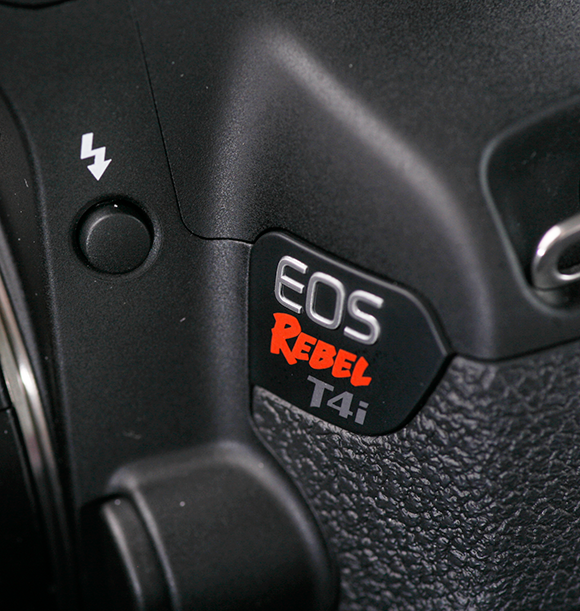
3.28 The button to activate the pop-up flash is on the front left of the Canon Rebel T4i/650D.
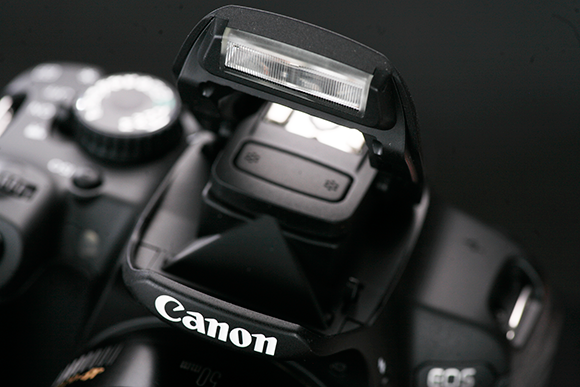
3.29 The Canon T4i/650D pop-up flash.
▶ Wireless. You can use the pop-up flash as a trigger for any external speedlites. To use your speedlite as an off-camera flash, switch it to Slave mode, and then press the Flash button (![]() ) on the left side of your camera. For the camera and speedlite to sync, both have to be set to the same channel (speedlites default to channel 1). You have up to four channels from which to choose, but I recommend sticking with channel 1 unless you have a specific reason to switch, such as when using a more complex lighting setup or there is a conflict with another photographer using the same channel.
) on the left side of your camera. For the camera and speedlite to sync, both have to be set to the same channel (speedlites default to channel 1). You have up to four channels from which to choose, but I recommend sticking with channel 1 unless you have a specific reason to switch, such as when using a more complex lighting setup or there is a conflict with another photographer using the same channel.
TIP For easy wireless flash photographs, press the Quick Control/Print button (![]() ) (in the creative zone modes only), and then press the Flash button (
) (in the creative zone modes only), and then press the Flash button (![]() ) on the right side of the LCD screen. Select the Easy Wireless Flash option (
) on the right side of the LCD screen. Select the Easy Wireless Flash option (![]() ).
).
▶ Flash Exposure Compensation. Sometimes you might disagree with the results that your camera and flash produce, and want your subject to appear a little lighter or darker. The Flash Exposure Compensation button (![]() ) lets you make adjustments in plus or minus 1/3-stop increments up to 2 stops. This option is useful in backlit situations. To quickly adjust the Flash Exposure Compensation when using a creative zone mode, press the Quick Control/Print button (
) lets you make adjustments in plus or minus 1/3-stop increments up to 2 stops. This option is useful in backlit situations. To quickly adjust the Flash Exposure Compensation when using a creative zone mode, press the Quick Control/Print button (![]() ), and then press the Flash Exposure Compensation button (
), and then press the Flash Exposure Compensation button (![]() ) below the ISO setting. This option is not available in basic zone modes.
) below the ISO setting. This option is not available in basic zone modes.
NOTE If the Auto Light Optimizer is on any setting, photos with a negative stop adjustment may still appear bright.
CAUTION Don’t forget to set the Flash Exposure Compensation setting (![]() ) back to 0 when you finish using it.
) back to 0 when you finish using it.
ISO Settings
The ISO setting represents the camera’s sensitivity to light. Your camera has eight settings ranging from ISO 100 to ISO 12800. ISO 25600 is available when Custom function 2 is engaged. Each step doubles or halves the amount of light sensitivity. This is the equivalent of changing the shutter or aperture 1 full stop. The higher the ISO setting, the less light you need for an exposure. The lower the ISO setting, the higher the quality or less digital noise will appear in your image.
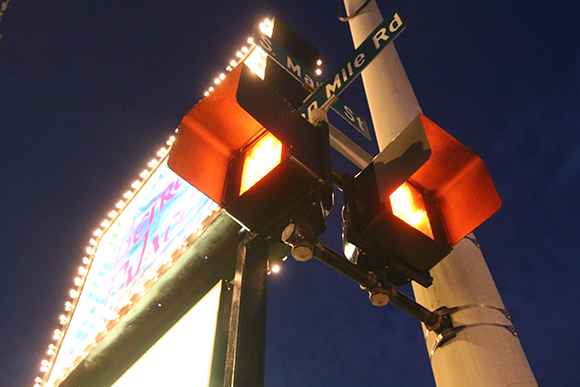
3.30 High ISO settings are helpful when shooting at night. (ISO 8000, f/5.6, 1/4 second)
To set the ISO, press the ISO button (![]() ) on top of your camera. There are eight options ranging from 100 to 12800. If you see the option H, this means that Custom function 2 (found in Setup menu 4 (
) on top of your camera. There are eight options ranging from 100 to 12800. If you see the option H, this means that Custom function 2 (found in Setup menu 4 (![]() )) is on and will set the ISO to 25600.
)) is on and will set the ISO to 25600.
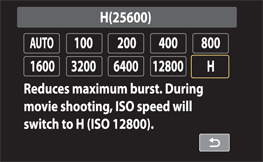
3.31 When Custom function 2 is selected, the ISO range extends to ISO 25600 (Custom Functions are found in Setup menu 4).
The lower ISO settings—ISO 100, ISO 200, and ISO 400—are good, all- purpose settings for use outside and in bright building interiors. Use ISO 800 and ISO 1600 when shooting in the evening, on overcast days, or indoors without a flash. When shooting at night or in a dark room, use ISO 3200, ISO 6400, ISO 12800, or ISO 25600. You can set the ISO at any point when using a creative zone mode. When your camera is set to a basic zone mode, the ISO is set automatically.
NOTE In Portrait mode (![]() ), your camera sets the ISO to 100. In the Bulb shooting mode (
), your camera sets the ISO to 100. In the Bulb shooting mode (![]() ), it sets the ISO to 400. The higher the ISO is, the farther the light of your flash extends.
), it sets the ISO to 400. The higher the ISO is, the farther the light of your flash extends.
When Auto ISO is set on your camera, it selects the proper setting based on the shooting mode. In this mode, the ISO ranges from ISO 100 to ISO 6400 in most modes. You can limit this range by setting a maximum ISO. To do this, press the Menu button (![]() ), choose menu 3 (third from the left), and then select Auto mode.
), choose menu 3 (third from the left), and then select Auto mode.
The higher the ISO setting, the more noise you see in your images. Noise is the digital equivalent of grain in film. Camera companies, including Canon, have done a good job of limiting noise as they increase the ISO limits in cameras. The Canon T4i/650D is equipped with noise-reduction technology. For example, in Shooting menu 3 (![]() ), select Highspeed noise NR to help reduce noise when you are photographing at a high ISO setting, such as ISO 12800. Another option in Shooting menu 3 (
), select Highspeed noise NR to help reduce noise when you are photographing at a high ISO setting, such as ISO 12800. Another option in Shooting menu 3 (![]() ) is Long exp. noise reduction, which is used for exposures over 1 second.
) is Long exp. noise reduction, which is used for exposures over 1 second.
Choosing File Quality and Format
The Canon Rebel T4i/650D has multiple file formats, and the quality option selection is not always easy. The best rule is to use the highest quality possible because you can always downsize, but you can’t upsize. Don’t be tempted by the large number of available photographs when you use a smaller file size and greater file compression. The number of photographs you can take may be impressive, but they will not be the best. If you need to take more images at one time, invest in larger memory cards. For the best quality results, set your camera to RAW (![]() ).
).
The maximum camera resolution is approximately 17.9 megapixels, or 5182 × 3456 pixels (based on an aspect ratio of 3:2). This is the equivalent of a 17 × 11 photograph at 300 dpi (dots per inch). Your camera offers additional file size options that create file sizes as small as 720 x 480 pixels. Although larger files take up more room on a memory card, I recommend that you use the largest file size possible. It is always better to have the option of downsizing your images later instead of wishing you had a larger photo after creating photo files that are too small.
CAUTION The RAW (![]() ) and Small 3 (
) and Small 3 (![]() ) file formats cannot be resized. Also, remember that resized images cannot be made larger later.
) file formats cannot be resized. Also, remember that resized images cannot be made larger later.
Image size and file numbering
Your camera’s multiple image sizes range from 0.35 to 17.9 megapixels. It is best to use the largest size possible. Sometimes, you may want to downsize an image. This can be done in the Canon Digital Photo Professional software (which came with your camera on the EOS Digital Solutions Disk), Photoshop, or with software on the web. You also have the option of adjusting the image size in your camera. To do so, press the Playback button (![]() ), find the photograph you want to resize, and then press the Quick Control/Print button (
), find the photograph you want to resize, and then press the Quick Control/Print button (![]() ). A menu appears on the left side of your screen and the bottom option is Image resize.
). A menu appears on the left side of your screen and the bottom option is Image resize.
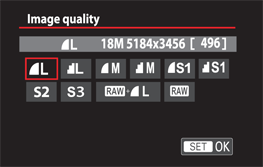
3.32 You have ten image quality options; RAW is the highest and S3 is the lowest.
CROSS REF For more information about the Canon Digital Photo Professional software, see Appendix A.
The files in your camera are numbered from 0001 to 9999 and continue in this same order, even if you replace the memory card. If you want the number system to restart, you can set your camera to do so at any point. To select the numbering system, go to Shooting menu 1 (![]() ) and select File numbering.
) and select File numbering.
NOTE You can create folders for more than one series of photos in Setup menu 1 (![]() ).
).
The RAW file format
When you want the highest quality possible, RAW (![]() ) is the best choice. However, you need special computer software to work with RAW files. Your camera comes with the EOS Digital Solutions Disk that includes the Canon Digital Photo Professional software. This program can handle RAW images and so can Photoshop.
) is the best choice. However, you need special computer software to work with RAW files. Your camera comes with the EOS Digital Solutions Disk that includes the Canon Digital Photo Professional software. This program can handle RAW images and so can Photoshop.
The good thing about the RAW file setting is that it stores the original data collected by your camera before a photograph is compressed into a Large fine JPEG image. When you make adjustments to compressed files, such as JPEGs, the images lose quality with each adjustment. When you use the RAW format with the proper software to make adjustments, it is like re-exposing your image without losing quality.
The JPEG file format
JPEG (Joint Photographic Experts Group) files are much smaller and easier to work with than RAW image files due to their size. This is the most common image file format used by photographers. One benefit of using JPEGs is the option to adjust the amount of compression applied to your photograph. The more a file is compressed, the smaller it is. However, the smaller a file is, the more information is lost. Your camera is capable of shooting in both the RAW and Large fine JPEG formats at the same time, giving you more options later in postproduction. However, this option also takes up more room on a memory card. If you are going to be shooting an event and taking a lot of photographs, the JPEG option is a good choice. It makes it easier to work with a large number of files later.
Your Canon Rebel T4i/650D offers the following eight JPEG size and compression options:
▶ Large fine (![]() ). Images at this setting are 17.9 megapixels. This is the highest-quality JPEG file setting your camera offers.
). Images at this setting are 17.9 megapixels. This is the highest-quality JPEG file setting your camera offers.
▶ Large normal (![]() ). These images are also 17.9 megapixels but, as it uses additional compression, you can store about double the number of images versus the Large fine setting.
). These images are also 17.9 megapixels but, as it uses additional compression, you can store about double the number of images versus the Large fine setting.
▶ Medium fine (![]() ). Images at this setting are 8 megapixels. This is a good average setting that still produces large prints.
). Images at this setting are 8 megapixels. This is a good average setting that still produces large prints.
▶ Medium normal (![]() ). These images are also 8 megapixels. However, this setting produces about double the amount of images compared to the Medium fine setting by using additional compression.
). These images are also 8 megapixels. However, this setting produces about double the amount of images compared to the Medium fine setting by using additional compression.
▶ Small fine (![]() ). Images at this setting are 4.5 megapixels—a very small file size. This setting is useful for photographs created for websites, social media, or small 4 × 6 prints.
). Images at this setting are 4.5 megapixels—a very small file size. This setting is useful for photographs created for websites, social media, or small 4 × 6 prints.
▶ Small normal (![]() ). Images at this setting are also 4.5 megapixels; however, additional compression means that it produces about double the amount of images compared to the Small fine setting.
). Images at this setting are also 4.5 megapixels; however, additional compression means that it produces about double the amount of images compared to the Small fine setting.
▶ Small 2 (![]() ). At 2.5 megapixels, images shot at this very small file size are best used for e-mail or the web.
). At 2.5 megapixels, images shot at this very small file size are best used for e-mail or the web.
▶ Small 3 (![]() ). Images shot at this setting are only 0.35 megapixels and, thus, are not ideal for most photography needs. However, this size is useful for special applications, such as web thumbnails or high-volume documentation.
). Images shot at this setting are only 0.35 megapixels and, thus, are not ideal for most photography needs. However, this size is useful for special applications, such as web thumbnails or high-volume documentation.
Movie Modes
To shoot a video, press the Movie mode button (![]() ) on the camera’s power switch. When shooting video, it is a good idea to use fast (class 6 or higher), large-capacity memory cards. Slower cards may not write as fast as the video is produced and playback quality could be affected. Your camera is considered full HD, meaning it has 1080 vertical pixels (or scanning lines) required for HD. When playing videos, connect your camera to a TV or monitor for better viewing.
) on the camera’s power switch. When shooting video, it is a good idea to use fast (class 6 or higher), large-capacity memory cards. Slower cards may not write as fast as the video is produced and playback quality could be affected. Your camera is considered full HD, meaning it has 1080 vertical pixels (or scanning lines) required for HD. When playing videos, connect your camera to a TV or monitor for better viewing.
CROSS REF See Chapter 9 for more about how to connect your camera to a television.
Exposing for video
If your camera is set to any of the basic zone modes, it defaults to the automatic Scene Intelligent Auto mode (![]() ). This means that the camera sets the shutter speed, aperture, and ISO. In Scene Intelligent Auto mode (
). This means that the camera sets the shutter speed, aperture, and ISO. In Scene Intelligent Auto mode (![]() ), the camera also applies scene detection filters to enhance the video. The scene filter the camera detects appears on the LCD screen in the upper-left side of the frame. Auto exposure is fine for casual shooting, but when you want higher-quality video, experienced videographers recommend using the Manual shooting mode (
), the camera also applies scene detection filters to enhance the video. The scene filter the camera detects appears on the LCD screen in the upper-left side of the frame. Auto exposure is fine for casual shooting, but when you want higher-quality video, experienced videographers recommend using the Manual shooting mode (![]() ). This is because the camera tries to make adjustments as the scene changes in the automatic modes. This may seem convenient but, unfortunately, the results don’t look very professional.
). This is because the camera tries to make adjustments as the scene changes in the automatic modes. This may seem convenient but, unfortunately, the results don’t look very professional.
It is highly recommended that you use the creative zone modes when shooting video. The camera treats Aperture-priority AE (![]() ), and Shutter-priority AE (
), and Shutter-priority AE (![]() ) modes the same as the Program (
) modes the same as the Program (![]() ) mode. The Program AE mode (
) mode. The Program AE mode (![]() ) sets the camera shutter speed, aperture, and ISO. The biggest difference between the Scene Intelligent Auto (
) sets the camera shutter speed, aperture, and ISO. The biggest difference between the Scene Intelligent Auto (![]() ) and Program AE (
) and Program AE (![]() ) modes is that Program AE mode (
) modes is that Program AE mode (![]() ) does not use scene detection. This means that you have more control over things like exposure compensation.
) does not use scene detection. This means that you have more control over things like exposure compensation.
Manual (![]() ) is the best mode for shooting high-quality video. It gives you control over the shutter speed, frame rate, aperture, and ISO (the range is ISO 100 to ISO 6400). Using Custom Function 2, you can set the ISO on High, which is the equivalent of ISO 12800. However, if you do this, you will encounter a lot of noise in your video and exposure compensation will no longer be available.
) is the best mode for shooting high-quality video. It gives you control over the shutter speed, frame rate, aperture, and ISO (the range is ISO 100 to ISO 6400). Using Custom Function 2, you can set the ISO on High, which is the equivalent of ISO 12800. However, if you do this, you will encounter a lot of noise in your video and exposure compensation will no longer be available.
CROSS REF For more about the relationship between shutter speed and frame rate, see Chapter 8.
Setting the file size and focus
The Canon Rebel T4i/650D has the following three video size options:
▶ 1920 × 1080 (30 or 24 fps)
▶ 1280 × 720 (60 fps)
▶ 640 × 480 (30 fps)
CROSS REF For more information about the effect the frame rate has on your videos, see Chapter 8.
Your camera has a shooting time limit of 29 minutes and 59 seconds. If you use the highest file size (1920 × 1080), you need at least a 16GB memory card to record uninterrupted for the full time available. When you reach 29 minutes and 59 seconds, the camera automatically stops recording. Press the Live View shooting mode button (![]() ) and the camera starts a new video file.
) and the camera starts a new video file.
NOTE Your camera turns on Live View Shooting mode (![]() ) for video capture and you have the same tracking options that you do when shooting still photography.
) for video capture and you have the same tracking options that you do when shooting still photography.
The default setting for video focus is Movie-servo AF (![]() ). This means that the camera focuses on the subject closest to it. You can turn this off by touching the Movie-servo AF (
). This means that the camera focuses on the subject closest to it. You can turn this off by touching the Movie-servo AF (![]() ) icon in the lower-left corner of the LCD screen. When Movie-servo AF mode (
) icon in the lower-left corner of the LCD screen. When Movie-servo AF mode (![]() ) is off, your camera focuses once when you press the shutter button halfway. If you are not using a Canon STM lens, the audio of your video will likely include lens focus noise. Consider using Manual focus for higher-level video productions—to do so, select the Manual focusing mode (
) is off, your camera focuses once when you press the shutter button halfway. If you are not using a Canon STM lens, the audio of your video will likely include lens focus noise. Consider using Manual focus for higher-level video productions—to do so, select the Manual focusing mode (![]() ) on your lens.
) on your lens.
NOTE If you press the shutter button all of the way, your camera takes a photo whether it is recording a movie or not.
Aaron Hockley’s Things to Check After a Shoot
After you return from a photo shoot, don’t immediately put your camera away—take a minute to reset your preferred settings. Any experienced photographer has grabbed his camera and started to shoot, only to realize that he left a setting in a strange position after an earlier outing.
Before you put your camera away, here are some things to check:
▶ The white balance. Reset it to Auto (![]() ).
).
▶ The shooting mode. Reset it to the mode you prefer.
▶ The ISO. Reset it to Auto or a low ISO setting
▶ The Mode dial. Do you like Program AE (![]() ), Aperture-priority AE (
), Aperture-priority AE (![]() ), or Manual (
), or Manual (![]() ) mode?
) mode?
▶ Make sure that a blank memory card is in the camera. There’s nothing worse than being ready to take a shot and discovering there’s no card in your camera.
▶ The image size/quality. If you prefer shooting in the RAW format, make sure that the camera is set to RAW (![]() ). If you’re a JPEG shooter, make sure that the camera is at your preferred quality setting.
). If you’re a JPEG shooter, make sure that the camera is at your preferred quality setting.
▶ Exposure compensation. Reset it to 0.
▶ Autofocus. Is it on? If so, to which mode is it set?
▶ The Metering mode. Set it to Evaluative (![]() ) or Spot (
) or Spot (![]() ) metering, depending on your preference.
) metering, depending on your preference.
Many of these settings are personal preferences, and there is no correct configuration. However, it’s important that you’re consistent so that each time you grab your camera, you get the results that you expect.
Aaron Hockley is an event, commercial, and portrait photographer from Vancouver, Washington. He shares commentary and information at his website: http://aaron hockley.com/
